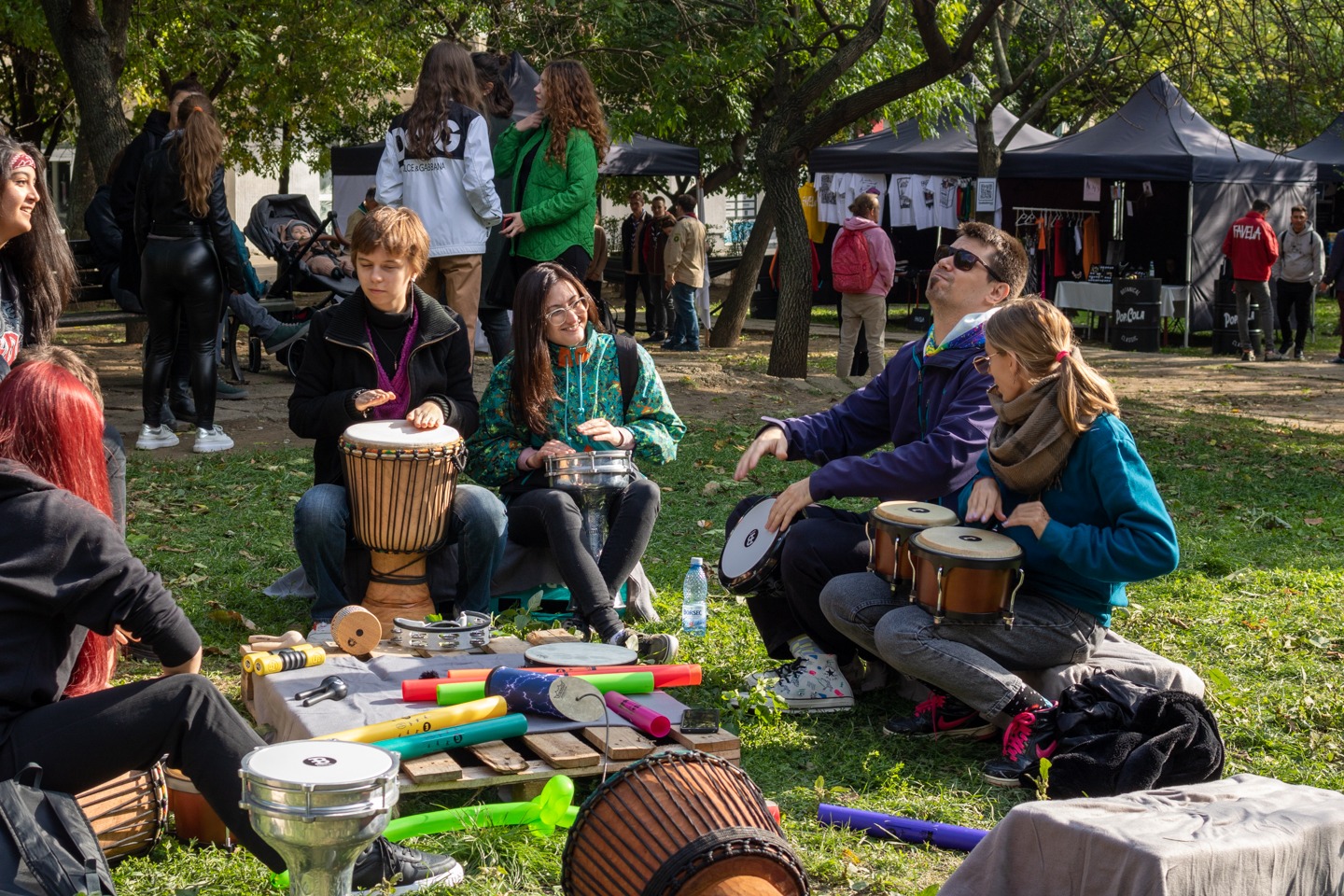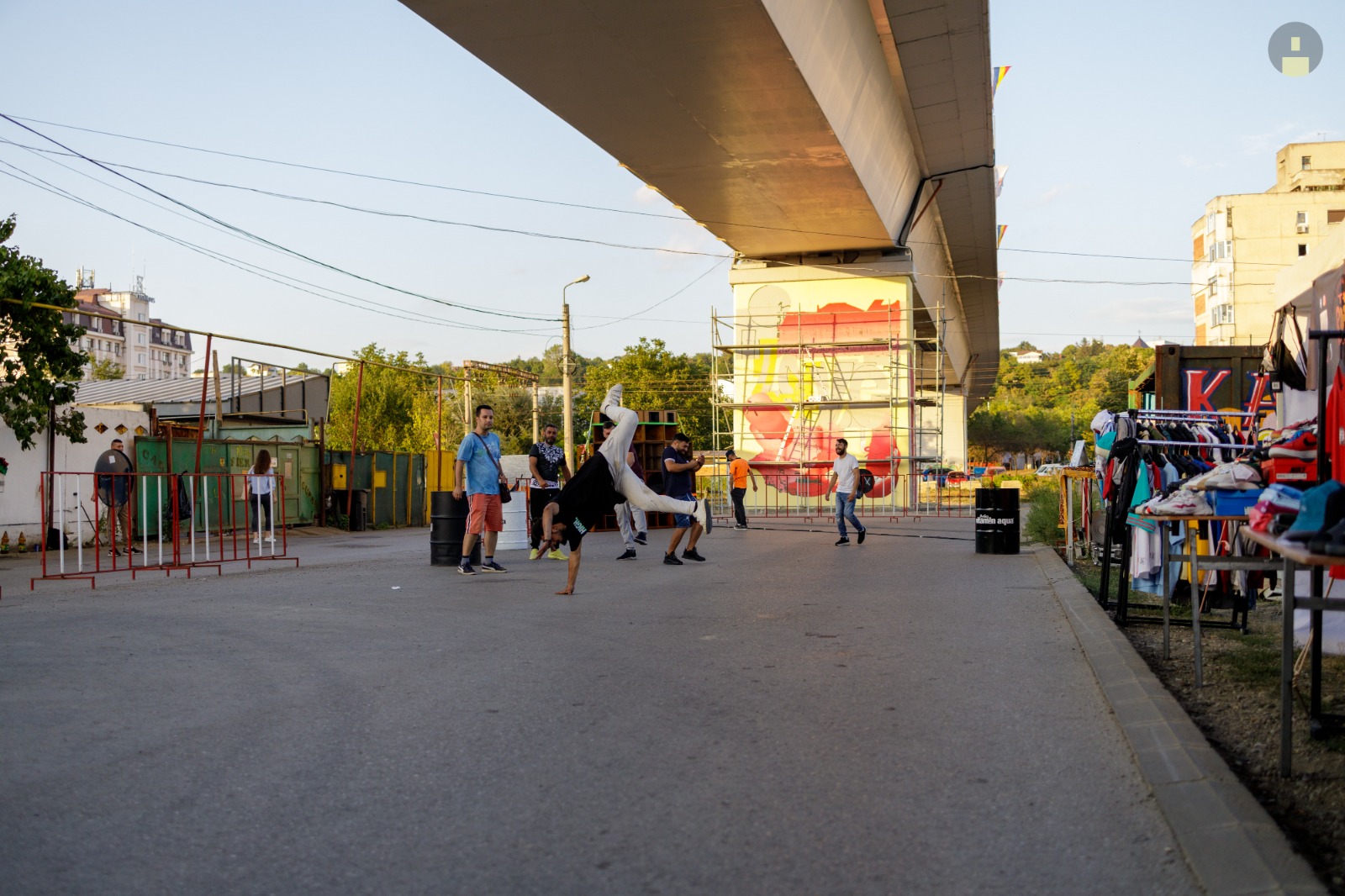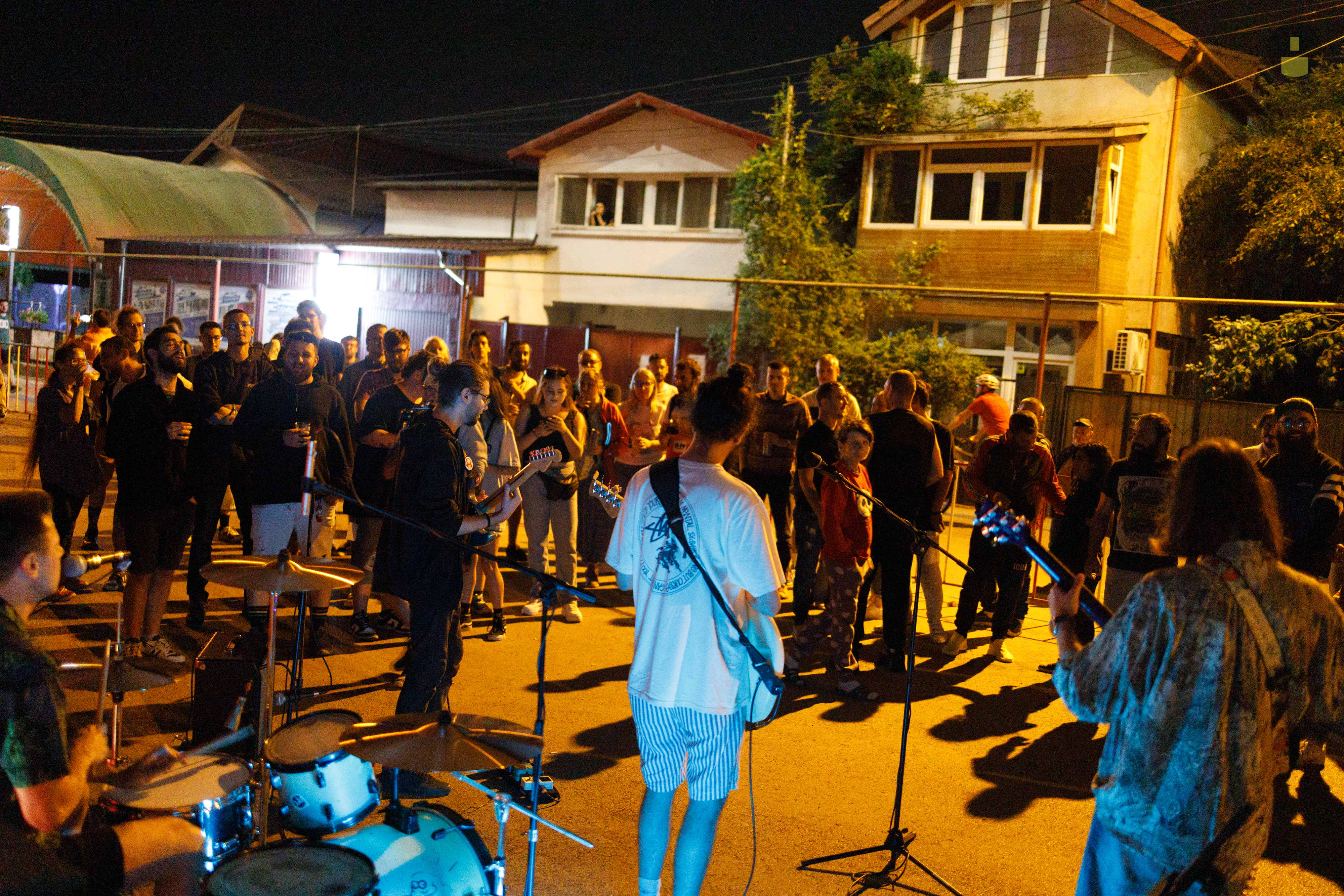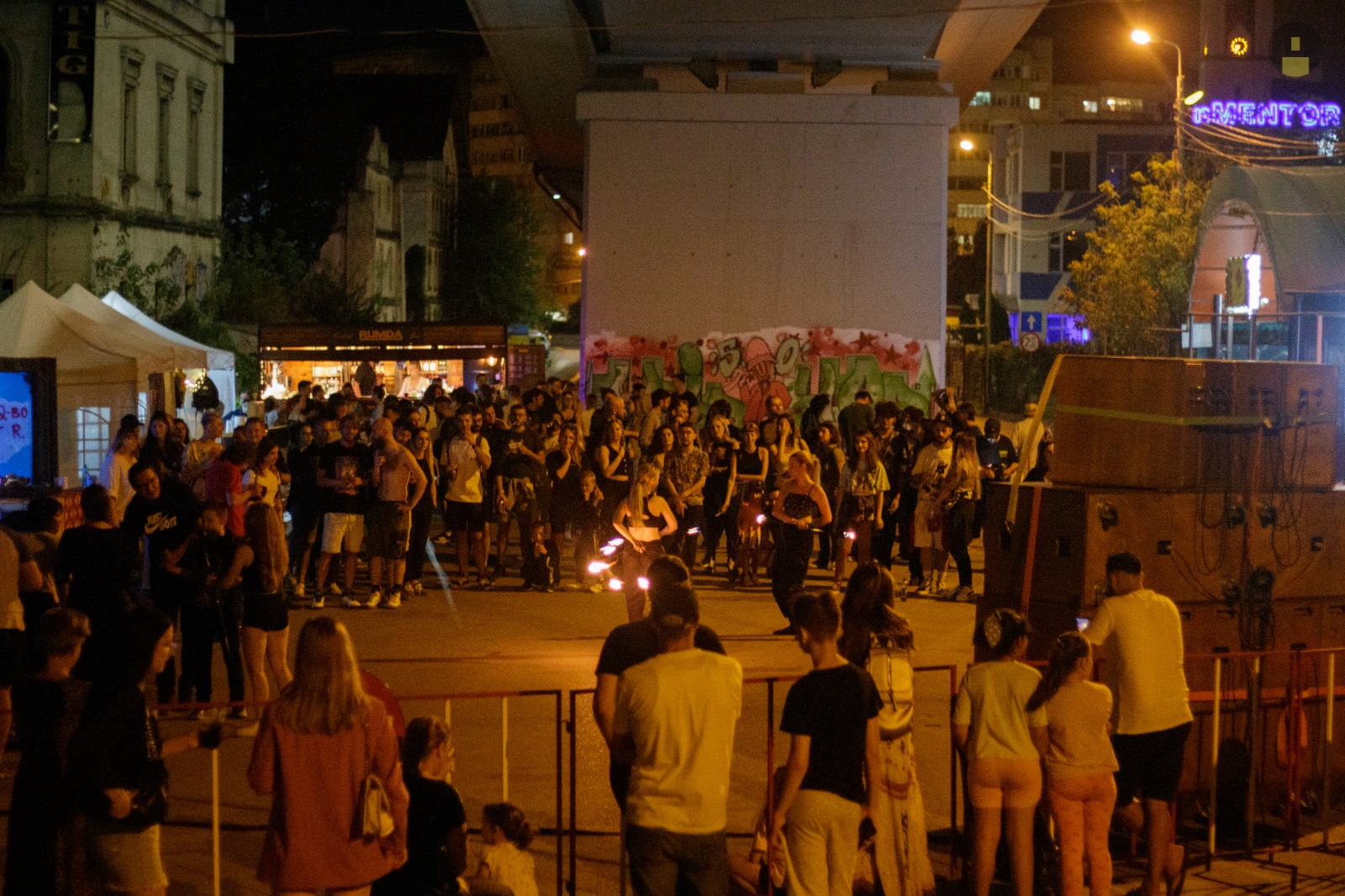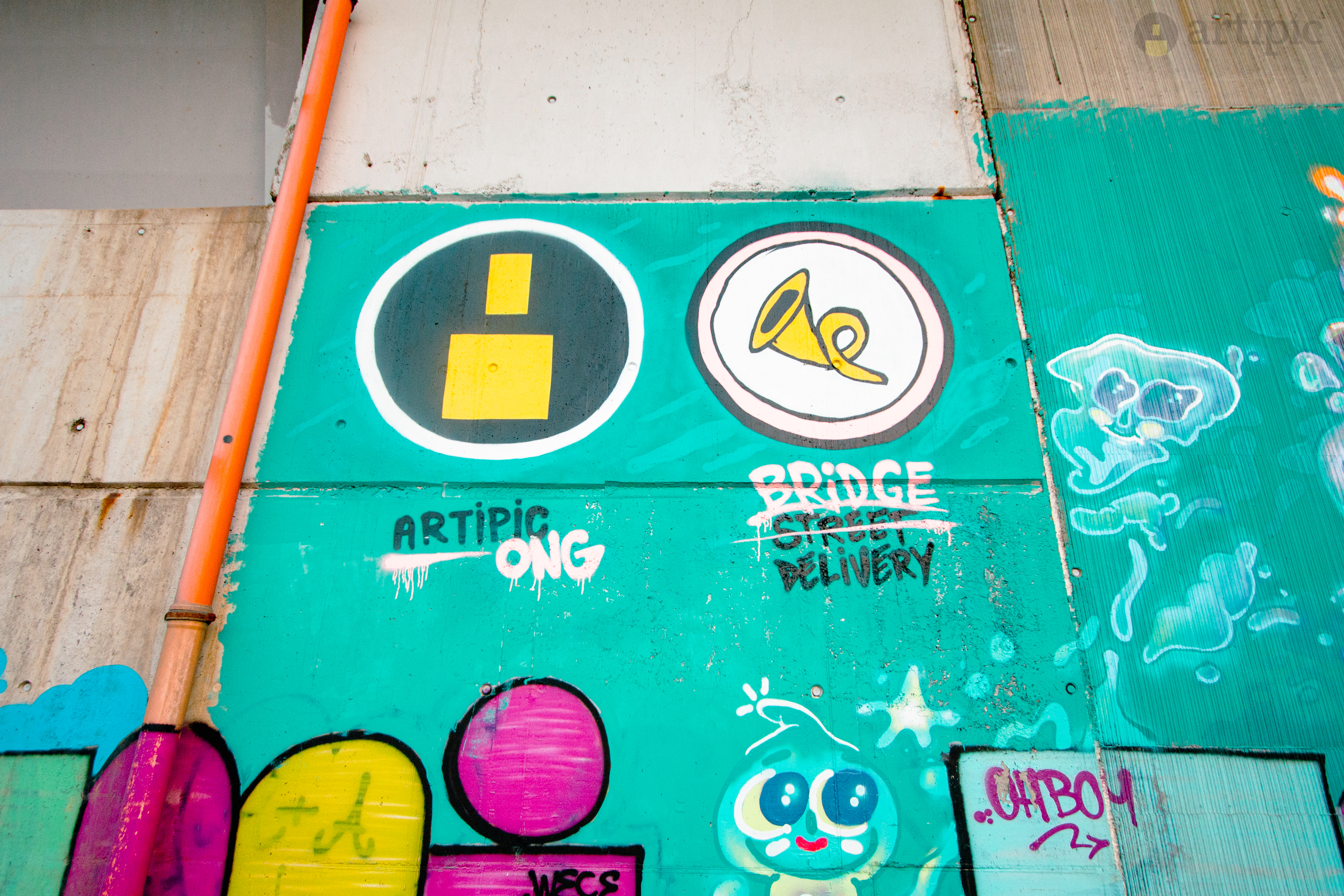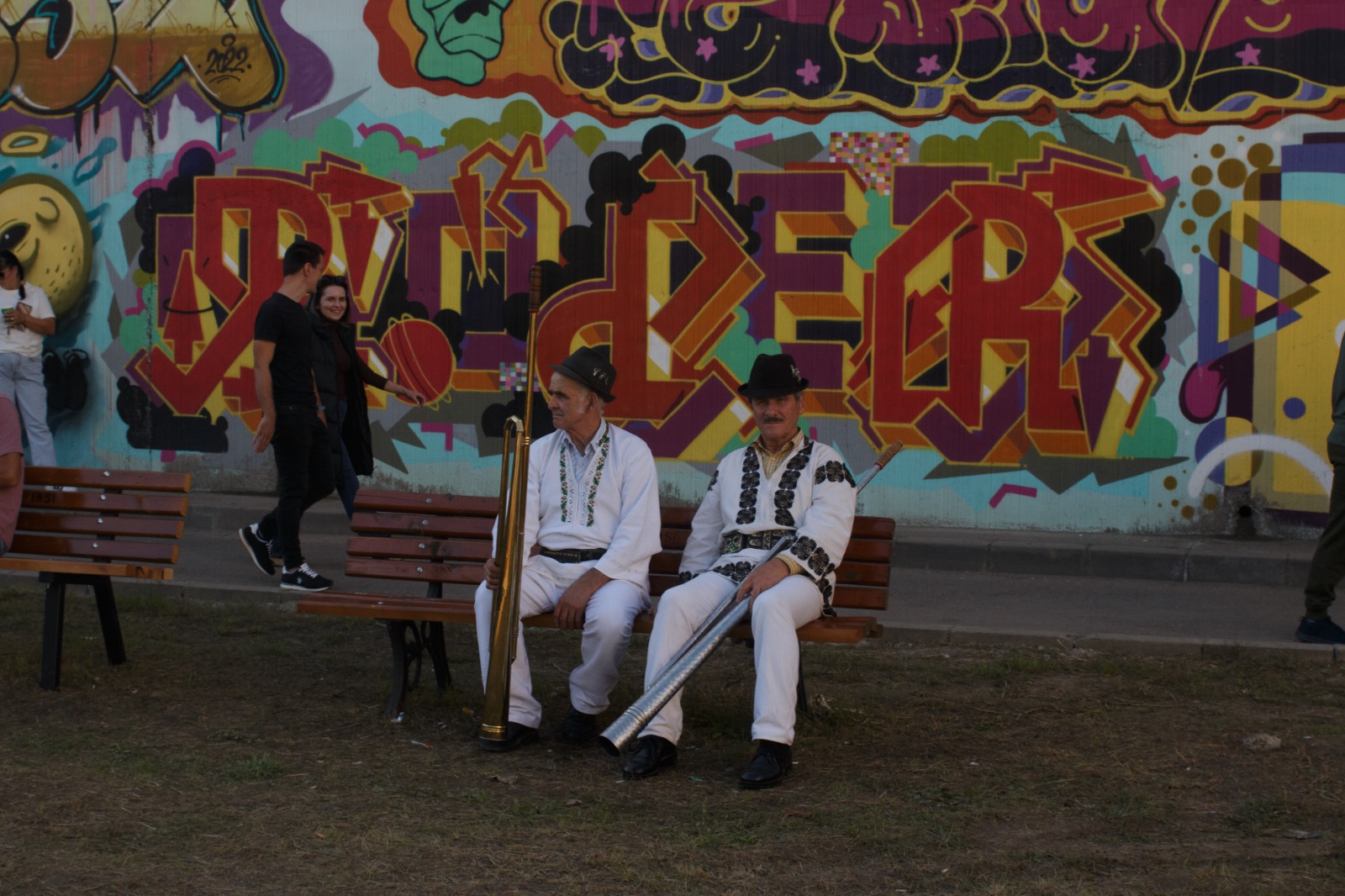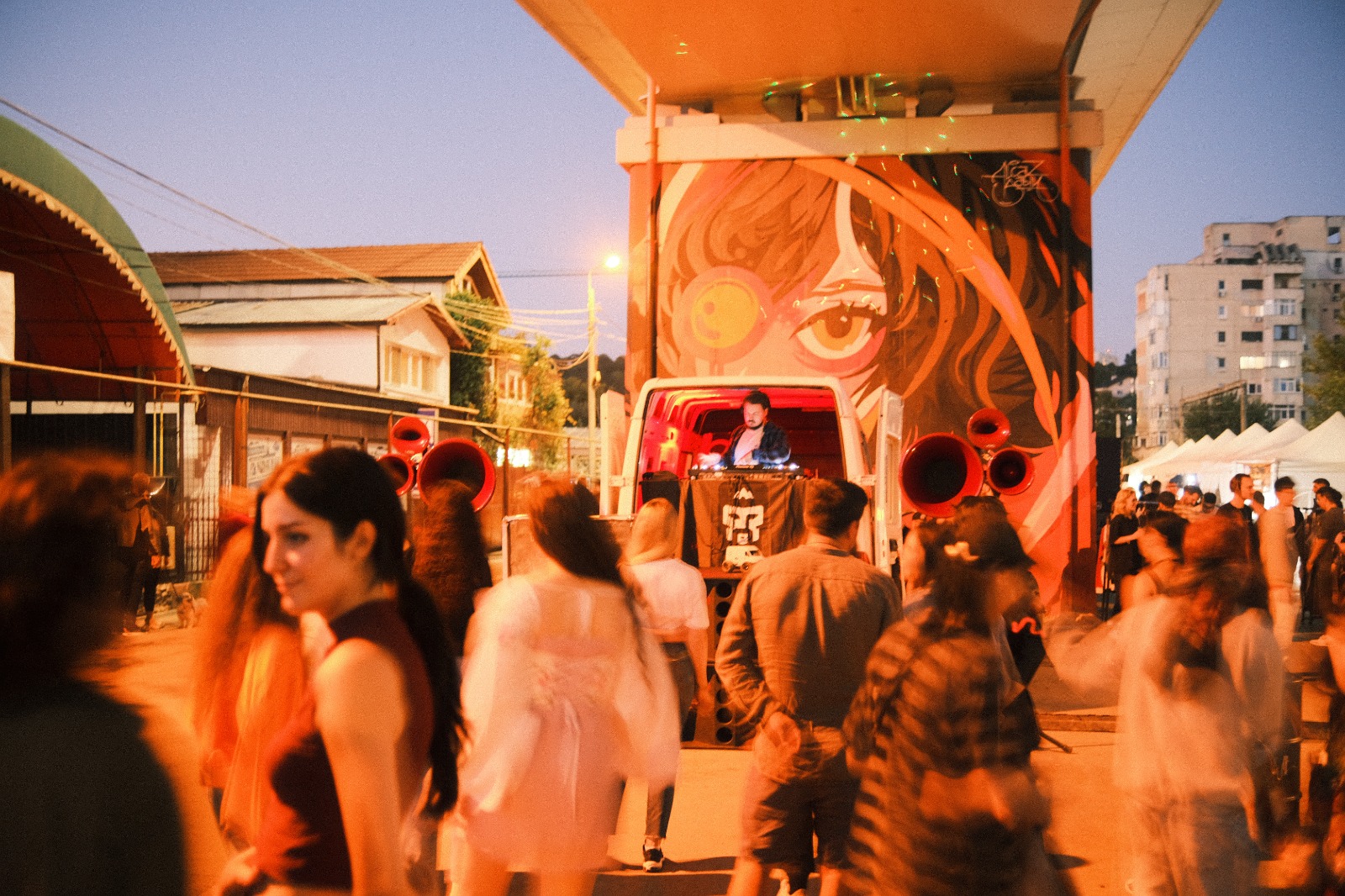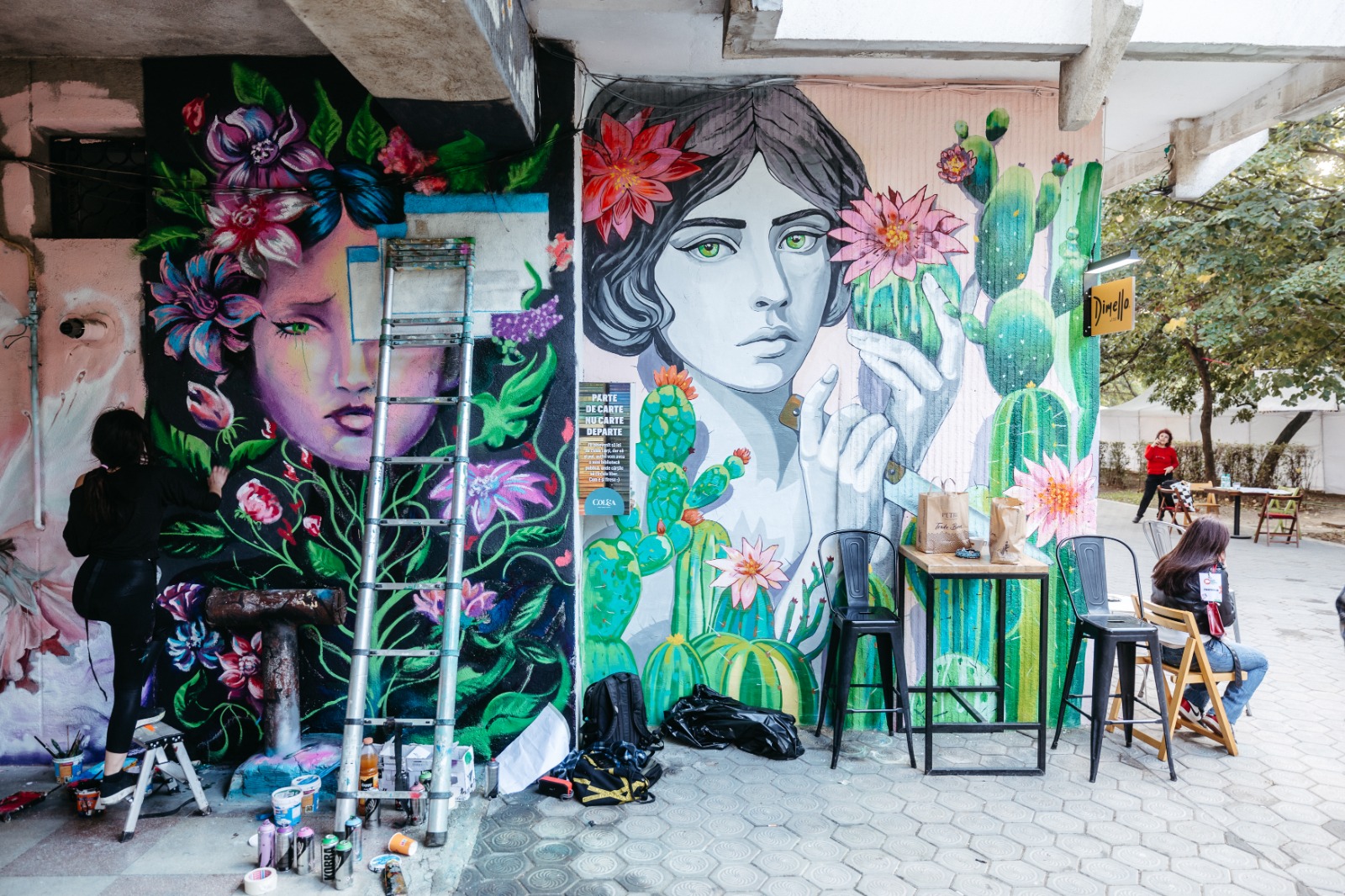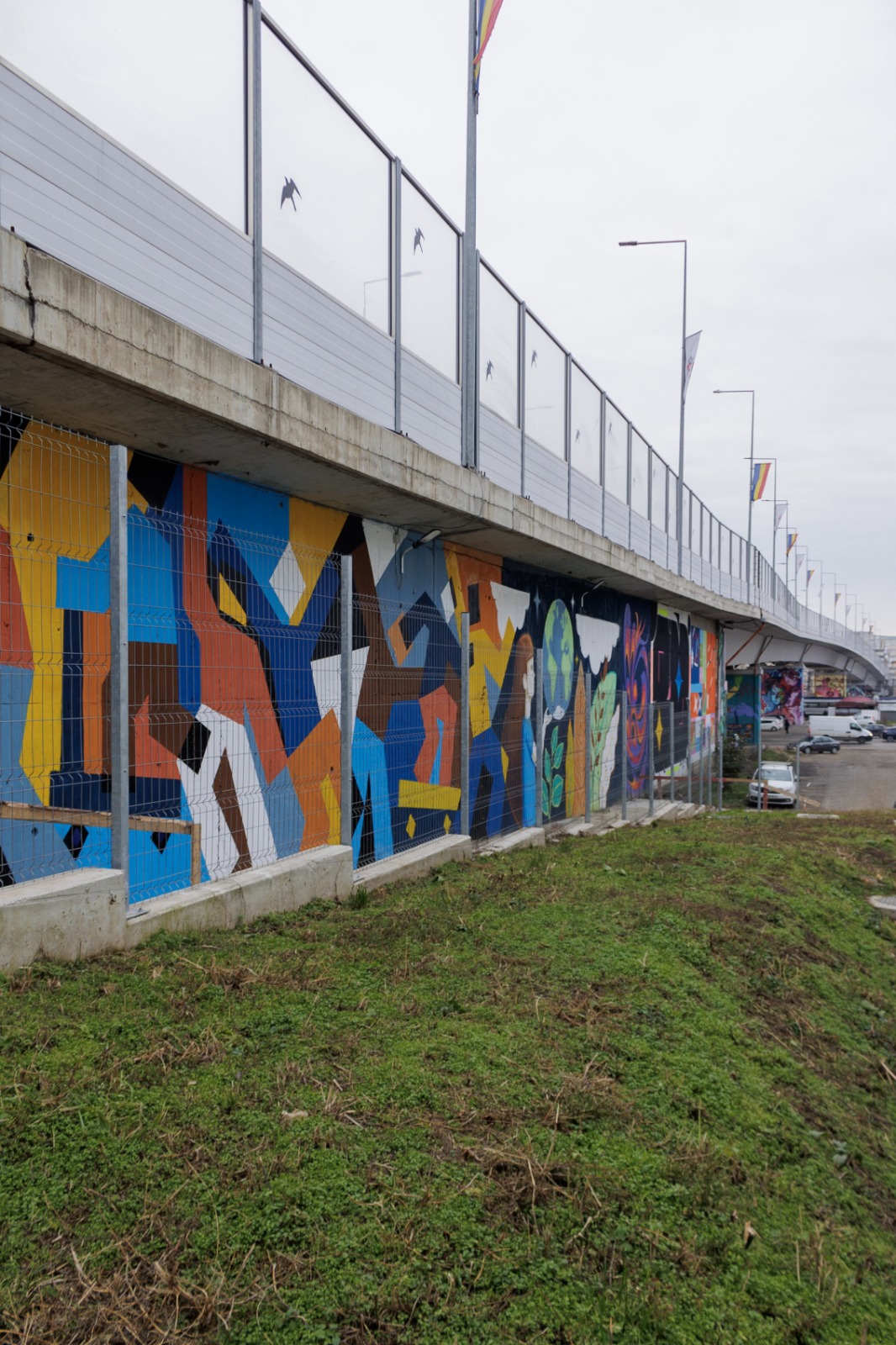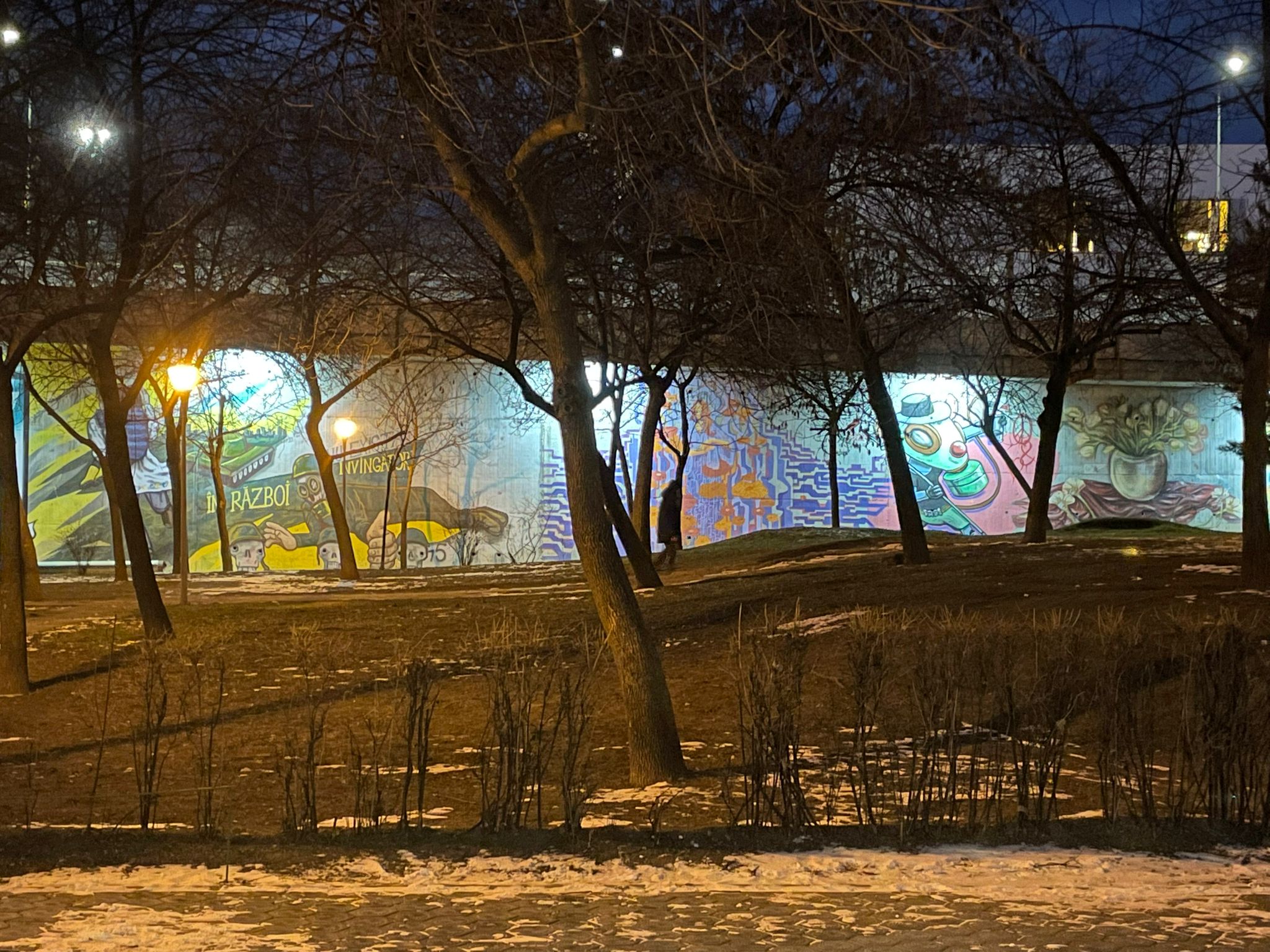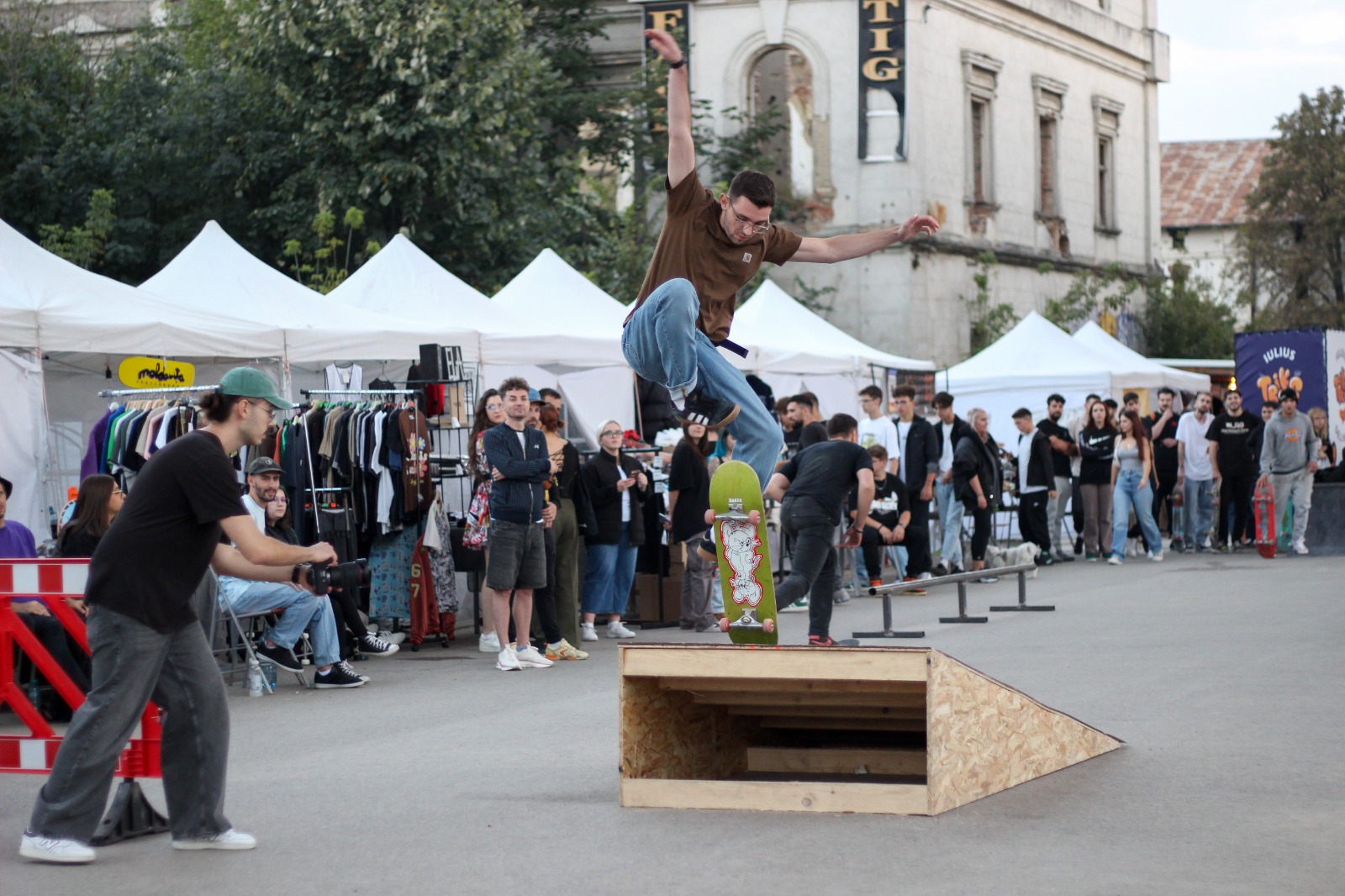Regaining a sense of belonging
Bridge Delivery
RegenerARTe Urbana + Street Delivery Iasi = Bridge Delivery
Bridge Delivery brings together two exciting initiatives: RegenerARTe Urbana and Street Delivery Iasi festival. From September 2022 to September 2024, we breathed new life into the Octav Bancila Overpass, turning it into a dynamic community hub by organising a huge festival there and bringing the area into the spotlight through artistic movements. Connecting five peripheral neighborhoods and the entire city, we transformed the way people engage with urban space.
Romania
Local
Iasi
Mainly urban
It refers to other types of transformations (soft investment)
Yes
2024-11-15
Yes
Creative Europe
No
No
As a representative of an organisation
Bridge Delivery is a project implemented between 2022 and 2024 (spanning three editions), aimed at revitalizing the Octav Bancila Overpass area. Situated at the crossroads of five peripheral neighborhoods in Iasi, this initiative brings together two main components:
RegenerARTe Urbana – revitalizing urban spaces through mural art, street art, and graffiti.
Street Delivery Iasi – an urban festival that temporarily closes streets to traffic, turning them into spaces for cultural and community events.
Our goals included:
- Launching one of Romania’s largest public, open air art galleries (1960 sq.m.), the largest in the region.
- Showcasing the untapped potential of the neglected Octav Bancila Overpass to the local community.
- Expanding cultural access for over 10,000 underserved individuals throughout the three editions.
- Fostering collaboration at local, national, and international levels, with over 100 organizations, 300 artists, and 3000 participants contributing to the project.
This project promotes sustainable and inclusive aesthetics, emphasizes co-creation and collaboration, encouraging innovation in a circular, sustainable manner. The initiative took a people-centered approach, making cultural heritage and diversity accessible and affordable, providing a local solution with global relevance.
The primary target group consisted of residents from the five neighborhoods surrounding the overpass, including working-class families, a small group of homeless individuals living in an abandoned cigarette factory (a historical monument), and a Roma community. Through this project, we aimed to improve the quality of life for these marginalized groups, nurturing a sense of belonging and involvement in urban change.
RegenerARTe Urbana – revitalizing urban spaces through mural art, street art, and graffiti.
Street Delivery Iasi – an urban festival that temporarily closes streets to traffic, turning them into spaces for cultural and community events.
Our goals included:
- Launching one of Romania’s largest public, open air art galleries (1960 sq.m.), the largest in the region.
- Showcasing the untapped potential of the neglected Octav Bancila Overpass to the local community.
- Expanding cultural access for over 10,000 underserved individuals throughout the three editions.
- Fostering collaboration at local, national, and international levels, with over 100 organizations, 300 artists, and 3000 participants contributing to the project.
This project promotes sustainable and inclusive aesthetics, emphasizes co-creation and collaboration, encouraging innovation in a circular, sustainable manner. The initiative took a people-centered approach, making cultural heritage and diversity accessible and affordable, providing a local solution with global relevance.
The primary target group consisted of residents from the five neighborhoods surrounding the overpass, including working-class families, a small group of homeless individuals living in an abandoned cigarette factory (a historical monument), and a Roma community. Through this project, we aimed to improve the quality of life for these marginalized groups, nurturing a sense of belonging and involvement in urban change.
Urban
Revitalization
Art
Community
Space
Bridge Delivery is a spinoff of the Street Delivery initiative, which began in Bucharest in 2006 and expanded to 10 cities across Romania. It serves as both an urban festival and a manifesto advocating for public space. By temporarily pedestrianizing streets, the event reimagines them as venues for visual arts and civic initiatives, emphasizing the need to prioritize people over cars. This shift supports sustainability by reducing car usage and lowering carbon footprints.
The initiative focuses on circularity. The project encourages reusing materials, with an emphasis on cleaning and repurposing painting equipment for future use. In the most recent edition, an upcycling workshop was held using empty spray cans. Artists from Italy and Ukraine guided 30 participants in transforming these cans into art pieces, decorations, or souvenirs, fostering creativity while promoting resourcefulness.
The project also takes significant steps towards environmental integration, particularly through green infrastructure. Efforts were made to rejuvenate the Octav Bancila Overpass and its surroundings, a neglected green space located on private property and beyond the scope of local authority renovation. The third edition furthered this commitment by cleaning and revitalizing the green area between the ruins of the former cigarette factory, converting it into a primary event space.
Local partners, such as the Mai Bine Association and social enterprises like CUIB and REDU, played a pivotal role by hosting activities that minimized environmental impact. These included picnics where attendees brought their own reusable tableware, workshops on climate change, and the sale of upcycled products.
Street Delivery exemplifies sustainable urban transformation by blending nature with city life, promoting circularity, and fostering community involvement in waste reduction. It stands as a powerful local solution for global challenges like sustainability and environmental education.
The initiative focuses on circularity. The project encourages reusing materials, with an emphasis on cleaning and repurposing painting equipment for future use. In the most recent edition, an upcycling workshop was held using empty spray cans. Artists from Italy and Ukraine guided 30 participants in transforming these cans into art pieces, decorations, or souvenirs, fostering creativity while promoting resourcefulness.
The project also takes significant steps towards environmental integration, particularly through green infrastructure. Efforts were made to rejuvenate the Octav Bancila Overpass and its surroundings, a neglected green space located on private property and beyond the scope of local authority renovation. The third edition furthered this commitment by cleaning and revitalizing the green area between the ruins of the former cigarette factory, converting it into a primary event space.
Local partners, such as the Mai Bine Association and social enterprises like CUIB and REDU, played a pivotal role by hosting activities that minimized environmental impact. These included picnics where attendees brought their own reusable tableware, workshops on climate change, and the sale of upcycled products.
Street Delivery exemplifies sustainable urban transformation by blending nature with city life, promoting circularity, and fostering community involvement in waste reduction. It stands as a powerful local solution for global challenges like sustainability and environmental education.
Bridge Delivery combines beauty with practicality, ensuring that its designs are not only visually captivating but also emotionally resonant. The initiative breathed new life into the overlooked Octav Bancila Overpass, transforming it into one of Romania's largest public, open-air art galleries. Once a neglected space avoided by locals, it is now vibrant, welcoming, and connected to the community’s cultural identity.
Following the success of the first edition, a local entrepreneur seized the opportunity, renting a nearby vacant commercial space once used for storage, and opened Colea Cafe—a dynamic community hub for cultural and social events. The café now features products from local artisans and artists, many using upcycled materials in their work. Similarly, Jolly Cafe, a café for children and parents, opened nearby, promoting sustainable living and educational events.
The murals created during the festival capture the essence of Octav Bancila, a renowned Romanian painter known for his powerful depictions of social struggles. By weaving Bancila's legacy into the artwork, the festival adds depth and meaning, strengthening the connection to the area’s history.
In addition to the murals, the ruins of the former cigarette factory were creatively used, turning the space into a cultural hotspot with a vibrant, independent spirit. The Octav Bancila overpass area now hosts events that celebrate local history and culture, fostering a strong sense of community.
Since Octav Bancila Park is privately owned and local authorities cannot intervene, we requested the installation of spotlights on the overpass to enhance the area’s visibility. After a year of persistent requests, the park and murals are now illuminated, further enhancing the space’s aesthetic appeal.
Community feedback has been overwhelmingly positive, with residents sharing how the project has revitalized their neighborhood. The area has sparked a renewed sense of local pride and cultural rejuvenation.
Following the success of the first edition, a local entrepreneur seized the opportunity, renting a nearby vacant commercial space once used for storage, and opened Colea Cafe—a dynamic community hub for cultural and social events. The café now features products from local artisans and artists, many using upcycled materials in their work. Similarly, Jolly Cafe, a café for children and parents, opened nearby, promoting sustainable living and educational events.
The murals created during the festival capture the essence of Octav Bancila, a renowned Romanian painter known for his powerful depictions of social struggles. By weaving Bancila's legacy into the artwork, the festival adds depth and meaning, strengthening the connection to the area’s history.
In addition to the murals, the ruins of the former cigarette factory were creatively used, turning the space into a cultural hotspot with a vibrant, independent spirit. The Octav Bancila overpass area now hosts events that celebrate local history and culture, fostering a strong sense of community.
Since Octav Bancila Park is privately owned and local authorities cannot intervene, we requested the installation of spotlights on the overpass to enhance the area’s visibility. After a year of persistent requests, the park and murals are now illuminated, further enhancing the space’s aesthetic appeal.
Community feedback has been overwhelmingly positive, with residents sharing how the project has revitalized their neighborhood. The area has sparked a renewed sense of local pride and cultural rejuvenation.
In Bridge Delivery, accessibility and equity are at the core of our approach, ensuring that sustainable and aesthetically pleasing solutions are available to all, especially those with limited opportunities. We prioritize making high-quality environments accessible to everyone, regardless of socioeconomic status, by addressing affordability, social equity, and inclusive design throughout the planning process.
We actively engaged a wide array of stakeholders, including students from Octav Bancila Belle Art High School, local citizens, and community members, in the design process. This collaborative effort united architects, artists, engineers, and designers to create a project that truly embodies the collective values and needs of the community.
Bridge Delivery fosters interdisciplinary collaboration by tapping into the expertise of professionals from architecture, design, engineering, and the arts. This integration of local, national, and international perspectives has been crucial in crafting creative solutions to urban challenges. The project offers a platform for projects and initiatives that focus on designing urban spaces that are adaptable to climate change and resilient to social, economic, and environmental pressures.
In our commitment to social inclusion, we began discussions with the local administration to explore the possibility of purchasing or exchanging properties with the owner of O. Bancila Park for renovation and community revitalization. While we have yet to receive a response, we are prepared to take this forward through an online petition if needed.
Our approach celebrates local traditions, cultural heritage, and community identities, combining them with postmodern sustainability. This is reflected in the fusion of historical elements (former cigarette factory) and modern influences (graffiti, street art, and murals), which honor the past while embracing the future through a public art gallery that serves the artistic needs of the community.
We actively engaged a wide array of stakeholders, including students from Octav Bancila Belle Art High School, local citizens, and community members, in the design process. This collaborative effort united architects, artists, engineers, and designers to create a project that truly embodies the collective values and needs of the community.
Bridge Delivery fosters interdisciplinary collaboration by tapping into the expertise of professionals from architecture, design, engineering, and the arts. This integration of local, national, and international perspectives has been crucial in crafting creative solutions to urban challenges. The project offers a platform for projects and initiatives that focus on designing urban spaces that are adaptable to climate change and resilient to social, economic, and environmental pressures.
In our commitment to social inclusion, we began discussions with the local administration to explore the possibility of purchasing or exchanging properties with the owner of O. Bancila Park for renovation and community revitalization. While we have yet to receive a response, we are prepared to take this forward through an online petition if needed.
Our approach celebrates local traditions, cultural heritage, and community identities, combining them with postmodern sustainability. This is reflected in the fusion of historical elements (former cigarette factory) and modern influences (graffiti, street art, and murals), which honor the past while embracing the future through a public art gallery that serves the artistic needs of the community.
The citizens living near Octav Bancila Overpass directly benefited from the beautification efforts, including mural paintings and improved safety through lighting installations. Over 20,000 people from the five surrounding neighborhoods have gained access to cultural and recreational activities near their homes during the three editions of the festival. People from other areas of the city also discovered the potential of these public spaces.
Civil society's involvement was crucial to the project's success. NGOs, informal groups, small businesses, and public institutions proposed and organized activities across various sectors: culture, arts, education, environmental protection, and community inclusion. This diverse participation filled the festival schedule and created a shared sense of ownership.
In the first edition, a local business owner provided space for storing materials at no cost. This led to a lasting impact: a local artist rented the space and opened Colea Cafe a family-run café that has become a community hub. The café offers local art, products, and cultural events, including workshops, concerts, exhibitions, and film screenings. The father-daughter owners have become the park's "guardians," caring for the space by cleaning it, adding lighting, installing bike racks, and organizing events such as theater performances and creative workshops. Also, Jolly Cafe, the first cafe for parents and children in town, has brought life to the area and new audiences through their customers.
The involvement of these citizens has transformed Octav Bancila Park into a vibrant, community-driven space. The café owners also act as intermediaries, notifying local authorities about issues like lighting or recycling bins, thus strengthening the collaboration between residents and public authorities. This high level of civic engagement has fostered a stronger sense of community pride and ownership.
Civil society's involvement was crucial to the project's success. NGOs, informal groups, small businesses, and public institutions proposed and organized activities across various sectors: culture, arts, education, environmental protection, and community inclusion. This diverse participation filled the festival schedule and created a shared sense of ownership.
In the first edition, a local business owner provided space for storing materials at no cost. This led to a lasting impact: a local artist rented the space and opened Colea Cafe a family-run café that has become a community hub. The café offers local art, products, and cultural events, including workshops, concerts, exhibitions, and film screenings. The father-daughter owners have become the park's "guardians," caring for the space by cleaning it, adding lighting, installing bike racks, and organizing events such as theater performances and creative workshops. Also, Jolly Cafe, the first cafe for parents and children in town, has brought life to the area and new audiences through their customers.
The involvement of these citizens has transformed Octav Bancila Park into a vibrant, community-driven space. The café owners also act as intermediaries, notifying local authorities about issues like lighting or recycling bins, thus strengthening the collaboration between residents and public authorities. This high level of civic engagement has fostered a stronger sense of community pride and ownership.
In the first edition, we primarily engaged local stakeholders such as NGOs, small businesses, public institutions, and individuals like artists and high school students. We partnered with Carturesti Foundation, which provided financial support (around €3,500 per edition) and provided us the brand identity of the Street Delivery festival. The City Hall funded part of the project annually, granted permission to paint the overpass, and provided logistical support (tents, toilets, recycling bins).
After the opening of Colea Cafe, this local café supported our initiative by offering logistics, drinks for artists and volunteers, and inviting music artists for performances in Octav Bancila Park.
In the second edition, we expanded involvement to more local and national stakeholders and invited artists from across Romania. In the final edition, the scope expanded further, with international artists from Italy and Ukraine joining the effort.
The growing involvement of NGOs, small businesses, and informal groups enriched the project with a variety of cultural and educational activities, including workshops, exhibitions, debates, and performances. Local organizations presented their work in a leisure fair and organized activities in diverse fields like art, music, dance, environmental protection, and STEM.
Internationally, graffiti artists and mural painters transformed the Octav Bancila Overpass into a vibrant urban art gallery and the whole bridge is now a massive work of art. The upcycling workshop led by Ukrainian and Italian artists, coordinated by local artist Harcea Pacea, was a key example of cross-border cooperation.
The diversity of artists, performers, and workshops added great value to the project, making it a multidisciplinary cultural initiative that reached a wide audience. Their collective input turned a neglected urban space into a thriving cultural hub, demonstrating the power of collaboration at all levels, from local to international.
After the opening of Colea Cafe, this local café supported our initiative by offering logistics, drinks for artists and volunteers, and inviting music artists for performances in Octav Bancila Park.
In the second edition, we expanded involvement to more local and national stakeholders and invited artists from across Romania. In the final edition, the scope expanded further, with international artists from Italy and Ukraine joining the effort.
The growing involvement of NGOs, small businesses, and informal groups enriched the project with a variety of cultural and educational activities, including workshops, exhibitions, debates, and performances. Local organizations presented their work in a leisure fair and organized activities in diverse fields like art, music, dance, environmental protection, and STEM.
Internationally, graffiti artists and mural painters transformed the Octav Bancila Overpass into a vibrant urban art gallery and the whole bridge is now a massive work of art. The upcycling workshop led by Ukrainian and Italian artists, coordinated by local artist Harcea Pacea, was a key example of cross-border cooperation.
The diversity of artists, performers, and workshops added great value to the project, making it a multidisciplinary cultural initiative that reached a wide audience. Their collective input turned a neglected urban space into a thriving cultural hub, demonstrating the power of collaboration at all levels, from local to international.
The project engaged various disciplines to create a diverse and enriching experience for participants and the public. These included:
- Graffiti, Street Art, and Mural Painting: Over 70 artists transformed the O. Bancila Overpass into one of Romania's largest public art galleries.
- Architecture and Engineering: Architects and engineers designed the space for practicality and aesthetics, ensuring proper lighting and sound.
- Performing Arts: Over 150 performers brought the space to life, engaging the audience with performances and workshops.
- New Media: 5 artists contributed immersive installations and video mapping, enhancing the evening atmosphere.
- Visual Arts: 15 artists exhibited their work (paintings, drawings, photography) and led live sessions and workshops.
- Cinematography: Feminist documentary projection, followed by artist talks, and a graffiti film was shown as a promotional event.
- Civil Society: Workshops, debates, and masterclasses encouraged active community participation.
- Environmental Protection: Sustainable activities such as a slow food picnic and reused material products emphasized environmental awareness.
- Sports: Demonstrations and workshops in street workout, skateboarding, slacklining, and more engaged the audience in physical activities.
- STEM: Scientific activities fostered curiosity and learning.
- Tourism: In collaboration with Iasi.Travel, we organized street art tours around the area and now there are special guided tours for the overpass.
- Leisure Activities: NGOs and businesses showcased their services, enriching the cultural experience.
- Journalism: magazines, radios and podcasts created materials about the artists, the local atmosphere and the results.
The multidisciplinary approach fostered interaction among diverse groups-artists, stakeholders, and audiences-creating lasting connections and a stronger sense of community. Artists and the public benefited from this shared experience, building collaborations
- Graffiti, Street Art, and Mural Painting: Over 70 artists transformed the O. Bancila Overpass into one of Romania's largest public art galleries.
- Architecture and Engineering: Architects and engineers designed the space for practicality and aesthetics, ensuring proper lighting and sound.
- Performing Arts: Over 150 performers brought the space to life, engaging the audience with performances and workshops.
- New Media: 5 artists contributed immersive installations and video mapping, enhancing the evening atmosphere.
- Visual Arts: 15 artists exhibited their work (paintings, drawings, photography) and led live sessions and workshops.
- Cinematography: Feminist documentary projection, followed by artist talks, and a graffiti film was shown as a promotional event.
- Civil Society: Workshops, debates, and masterclasses encouraged active community participation.
- Environmental Protection: Sustainable activities such as a slow food picnic and reused material products emphasized environmental awareness.
- Sports: Demonstrations and workshops in street workout, skateboarding, slacklining, and more engaged the audience in physical activities.
- STEM: Scientific activities fostered curiosity and learning.
- Tourism: In collaboration with Iasi.Travel, we organized street art tours around the area and now there are special guided tours for the overpass.
- Leisure Activities: NGOs and businesses showcased their services, enriching the cultural experience.
- Journalism: magazines, radios and podcasts created materials about the artists, the local atmosphere and the results.
The multidisciplinary approach fostered interaction among diverse groups-artists, stakeholders, and audiences-creating lasting connections and a stronger sense of community. Artists and the public benefited from this shared experience, building collaborations
The innovative character of the Bridge Delivery project lies in its approach to urban regeneration and cultural engagement, particularly in a city like Iași, which has a conservative and traditional outlook. While Iași is often associated with its historical significance and Orthodox identity, the Bridge Delivery festival breaks away from this narrative by bringing modern, inclusive cultural experiences to neglected areas, away from the city center.
Unlike mainstream events that typically take place in the central or tourist-friendly areas, Bridge Delivery focuses on revitalizing peripheral neighborhoods that often lack cultural initiatives. This is particularly significant in Iași, where most events take place in the city center, neglecting the needs and potential of the outer districts. The festival transforms the Octav Bancila Overpass, a previously neglected area, into a vibrant urban art space, accessible to all.
Another aspect is the festival's free entry policy, ensuring accessibility to individuals regardless of their economic status. Most festivals in Romania are either held in paid-access venues or focused on city center locations. Bridge Delivery stands out by offering free cultural experiences to over 20,000 people from various socioeconomic backgrounds. Moreover, it gives to LGBT communities a safe place to display their values.
Furthermore, the project fosters local, national, and international collaborations, involving over 70 artists and stakeholders from various fields, including visual arts, architecture, engineering, and performing arts. It provides a platform for diverse creative expressions while encouraging intercultural dialogue and engagement across borders.
The project also contributes to urban regeneration by transforming neglected spaces into functional, aesthetic, and culturally significant areas, reflecting the progressive and inclusive vision that is still underdeveloped in Iași's public and cultural policies.
Unlike mainstream events that typically take place in the central or tourist-friendly areas, Bridge Delivery focuses on revitalizing peripheral neighborhoods that often lack cultural initiatives. This is particularly significant in Iași, where most events take place in the city center, neglecting the needs and potential of the outer districts. The festival transforms the Octav Bancila Overpass, a previously neglected area, into a vibrant urban art space, accessible to all.
Another aspect is the festival's free entry policy, ensuring accessibility to individuals regardless of their economic status. Most festivals in Romania are either held in paid-access venues or focused on city center locations. Bridge Delivery stands out by offering free cultural experiences to over 20,000 people from various socioeconomic backgrounds. Moreover, it gives to LGBT communities a safe place to display their values.
Furthermore, the project fosters local, national, and international collaborations, involving over 70 artists and stakeholders from various fields, including visual arts, architecture, engineering, and performing arts. It provides a platform for diverse creative expressions while encouraging intercultural dialogue and engagement across borders.
The project also contributes to urban regeneration by transforming neglected spaces into functional, aesthetic, and culturally significant areas, reflecting the progressive and inclusive vision that is still underdeveloped in Iași's public and cultural policies.
The methodology of the Bridge Delivery project combines 2 main initiatives aimed at urban regeneration and cultural enrichment:
RegenerARTe Urbana: This initiative focuses on transforming the Octav Bancila overpass area through graffiti, street art, and mural painting. We engaged 15 high school students from the Octav Bancila National Arts College, along with 57 local, national, and international graffiti writers and muralists, creating the largest graffiti production in Romania in 2022 and one of the biggest public art galleries in the region by 2024. Artists from Ukraine and Italy participated in artistic residencies, immersing themselves in Iași's culture to produce murals inspired by the city’s history and identity. After each edition, we organized street art tours showcasing the newly created murals and updated online maps to highlight these artistic developments. This initiative fostered a connection between the community and global street art, promoting artistic expression in a previously neglected area.
Street Delivery Iași: This 3 days festival reclaims public space for pedestrians and fosters community connections through diverse artistic and social activities. Initially focused on Octav Bancila Park, the festival expanded to include the former Cigarettes Factory area in the second and third editions. Activities included performances, demonstrations, workshops, and an immersive art installation, with both small businesses and NGOs taking part. The festival featured music stages, educational activities and opportunities for collaboration with local partners, who had the freedom to propose their own activities. The festival’s inclusive and participatory approach allowed stakeholders to contribute freely, with support provided by the project.
By combining urban art with community-driven events, the methodology encourages creativity, inclusivity, and the regeneration of public spaces, allowing residents to reconnect with their environment and each other.
RegenerARTe Urbana: This initiative focuses on transforming the Octav Bancila overpass area through graffiti, street art, and mural painting. We engaged 15 high school students from the Octav Bancila National Arts College, along with 57 local, national, and international graffiti writers and muralists, creating the largest graffiti production in Romania in 2022 and one of the biggest public art galleries in the region by 2024. Artists from Ukraine and Italy participated in artistic residencies, immersing themselves in Iași's culture to produce murals inspired by the city’s history and identity. After each edition, we organized street art tours showcasing the newly created murals and updated online maps to highlight these artistic developments. This initiative fostered a connection between the community and global street art, promoting artistic expression in a previously neglected area.
Street Delivery Iași: This 3 days festival reclaims public space for pedestrians and fosters community connections through diverse artistic and social activities. Initially focused on Octav Bancila Park, the festival expanded to include the former Cigarettes Factory area in the second and third editions. Activities included performances, demonstrations, workshops, and an immersive art installation, with both small businesses and NGOs taking part. The festival featured music stages, educational activities and opportunities for collaboration with local partners, who had the freedom to propose their own activities. The festival’s inclusive and participatory approach allowed stakeholders to contribute freely, with support provided by the project.
By combining urban art with community-driven events, the methodology encourages creativity, inclusivity, and the regeneration of public spaces, allowing residents to reconnect with their environment and each other.
The Bridge Delivery project has high potential for transferability and replicability across different locations and communities. Its key elements can be adapted to any neglected or underused public space, turning it into a vibrant cultural hub. The approach is flexible, depending on the size and context of the area, with activities tailored to local needs and available resources.
Key transferable aspects include:
Urban Regeneration Through Art: Transforming neglected spaces into urban art galleries using murals and graffiti is a process that can be replicated anywhere. Local and international artists can be involved, enriching the area with cultural expressions.
Community Engagement and Collaboration: The success of the project relies on active community involvement. Partnerships with local NGOs, businesses, and stakeholders create a sustainable framework, easily replicable in other locations.
Flexible Activities: The project offers various activities, from street art and music to sports and workshops, adaptable to different communities. These activities can be tailored to local interests and challenges.
Building Local Support: Securing logistical, financial, and human resources through community engagement is crucial. Local support increases the project's sustainability, making it easier to execute and more cost-effective.
Partnerships and Networking: The project thrives on collaborations across sectors—public, private, cultural, and civil society. By transferring these partnerships and networks, the model can be replicated to extend its impact.
This methodology will be applied to new areas like “Dallas” (a marginalized roma community in Iași), continuing the focus on revitalizing neglected spaces through art and community-driven activities. By engaging the community and stakeholders, the project will foster local ownership and long-term success.
Key transferable aspects include:
Urban Regeneration Through Art: Transforming neglected spaces into urban art galleries using murals and graffiti is a process that can be replicated anywhere. Local and international artists can be involved, enriching the area with cultural expressions.
Community Engagement and Collaboration: The success of the project relies on active community involvement. Partnerships with local NGOs, businesses, and stakeholders create a sustainable framework, easily replicable in other locations.
Flexible Activities: The project offers various activities, from street art and music to sports and workshops, adaptable to different communities. These activities can be tailored to local interests and challenges.
Building Local Support: Securing logistical, financial, and human resources through community engagement is crucial. Local support increases the project's sustainability, making it easier to execute and more cost-effective.
Partnerships and Networking: The project thrives on collaborations across sectors—public, private, cultural, and civil society. By transferring these partnerships and networks, the model can be replicated to extend its impact.
This methodology will be applied to new areas like “Dallas” (a marginalized roma community in Iași), continuing the focus on revitalizing neglected spaces through art and community-driven activities. By engaging the community and stakeholders, the project will foster local ownership and long-term success.
The Bridge Delivery project addresses several global challenges by providing local solutions:
Social Inclusion and Equity: The project ensures accessibility and equity by involving diverse communities, including marginalized groups. It provides cultural and social opportunities to all, regardless of socio-economic or physical background, ensuring no one is excluded.
Cultural Diversity: The project embraces cultural diversity by integrating national and international artistic expressions, such as graffiti and mural painting, into public spaces. This approach helps balance the aesthetic challenges posed by brutalist architecture and fosters a sense of unity while respecting cultural differences.
Economic Viability: One of the challenges for economically struggling communities is finding affordable ways to revitalize spaces. Urban art, a cost-effective form, provides an affordable yet impactful solution to enhance public spaces, making them more attractive without high costs.
Collaboration Across Borders: The project encourages cross-border cooperation between artists, architects, engineers, and local stakeholders. By involving international artists and organizations, the initiative strengthens collaboration for common goals, demonstrating how global cooperation can address local challenges.
Urbanization and Population Growth: The project addresses the growing need for sustainable urban spaces by improving neglected areas. It demonstrates how creative interventions can meet the demands of urbanization, enhancing the quality of life in rapidly expanding cities without harming the environment.
Changing Consumer Habits: The project promotes sustainable, aesthetic, and inclusive living standards by encouraging local communities and institutions to adopt more responsible and forward-thinking ways of engaging with their environment.
Through these efforts, the Bridge Delivery project helps bridge global challenges with locally-driven, impactful solutions.
Social Inclusion and Equity: The project ensures accessibility and equity by involving diverse communities, including marginalized groups. It provides cultural and social opportunities to all, regardless of socio-economic or physical background, ensuring no one is excluded.
Cultural Diversity: The project embraces cultural diversity by integrating national and international artistic expressions, such as graffiti and mural painting, into public spaces. This approach helps balance the aesthetic challenges posed by brutalist architecture and fosters a sense of unity while respecting cultural differences.
Economic Viability: One of the challenges for economically struggling communities is finding affordable ways to revitalize spaces. Urban art, a cost-effective form, provides an affordable yet impactful solution to enhance public spaces, making them more attractive without high costs.
Collaboration Across Borders: The project encourages cross-border cooperation between artists, architects, engineers, and local stakeholders. By involving international artists and organizations, the initiative strengthens collaboration for common goals, demonstrating how global cooperation can address local challenges.
Urbanization and Population Growth: The project addresses the growing need for sustainable urban spaces by improving neglected areas. It demonstrates how creative interventions can meet the demands of urbanization, enhancing the quality of life in rapidly expanding cities without harming the environment.
Changing Consumer Habits: The project promotes sustainable, aesthetic, and inclusive living standards by encouraging local communities and institutions to adopt more responsible and forward-thinking ways of engaging with their environment.
Through these efforts, the Bridge Delivery project helps bridge global challenges with locally-driven, impactful solutions.
The Bridge Delivery project has transformed the Octav Bancila Overpass area, fostering a strong sense of belonging and community connection.
Urban Regeneration: One of Romania’s largest public outdoor art galleries was created, transforming a neglected space into a vibrant cultural hub. The mural paintings connect local historical heritage with contemporary artistic dynamics, offering a new sense of identity. The Overpass and surrounding areas now reflect the diversity and creativity of the community.
Community Engagement: The project grew every year, with increasing participation from locals, artists, and organizations. Over 20000 people now feel a sense of ownership in their neighborhood. Residents actively maintain the space, ensuring its ongoing transformation and involvement in local life.
Economic and Cultural Development: A local resident opened Colea Cafe, a cultural space that further contributes to the community. Our initiative attracted an investor who will transform the historical ruins of a nearby ex-tobacco factory into an extensive urban regeneration project, with leisure activities, brewery, restaurant and a small urban forest, enhancing the area’s potential.
Tourism and Regional Impact: The revitalized area attracts both locals and tourists, with over 100000 people from other neighborhoods visiting. Its proximity to transport hubs makes it an accessible destination, drawing attention to this once-overlooked part of the city.
Social Well-being: The project has had a significant social impact, with residents expressing gratitude. The event has become important for families, children, small businesses, and marginalized groups like the homeless. It has fostered inclusivity and community engagement.
In conclusion, Bridge Delivery has restored a sense of belonging and ownership to the Octav Bancila Overpass, benefiting over 20000 residents and inspiring visitors. It has transformed a neglected space into a lively cultural and community destination.
Urban Regeneration: One of Romania’s largest public outdoor art galleries was created, transforming a neglected space into a vibrant cultural hub. The mural paintings connect local historical heritage with contemporary artistic dynamics, offering a new sense of identity. The Overpass and surrounding areas now reflect the diversity and creativity of the community.
Community Engagement: The project grew every year, with increasing participation from locals, artists, and organizations. Over 20000 people now feel a sense of ownership in their neighborhood. Residents actively maintain the space, ensuring its ongoing transformation and involvement in local life.
Economic and Cultural Development: A local resident opened Colea Cafe, a cultural space that further contributes to the community. Our initiative attracted an investor who will transform the historical ruins of a nearby ex-tobacco factory into an extensive urban regeneration project, with leisure activities, brewery, restaurant and a small urban forest, enhancing the area’s potential.
Tourism and Regional Impact: The revitalized area attracts both locals and tourists, with over 100000 people from other neighborhoods visiting. Its proximity to transport hubs makes it an accessible destination, drawing attention to this once-overlooked part of the city.
Social Well-being: The project has had a significant social impact, with residents expressing gratitude. The event has become important for families, children, small businesses, and marginalized groups like the homeless. It has fostered inclusivity and community engagement.
In conclusion, Bridge Delivery has restored a sense of belonging and ownership to the Octav Bancila Overpass, benefiting over 20000 residents and inspiring visitors. It has transformed a neglected space into a lively cultural and community destination.

